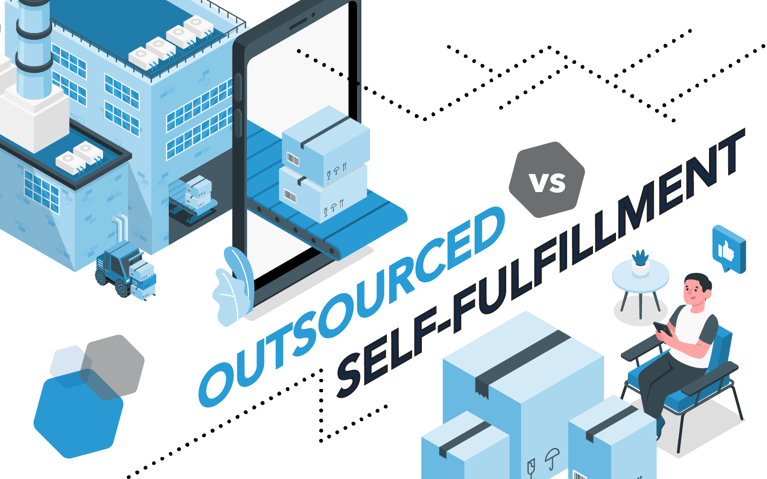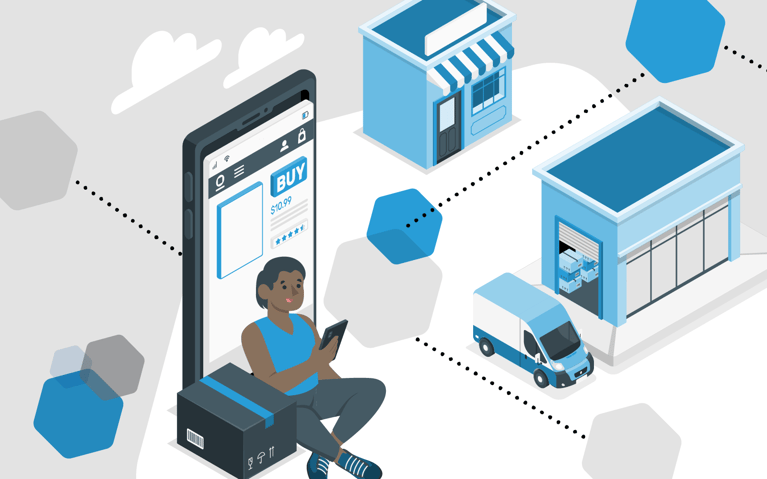Omnichannel fulfillment and multichannel fulfillment are both strategies for serving customers across various sales and distribution channels, we know, but what are the main differences?
Which fulfillment strategy is best, Omnichannel or Multichannel?
One obvious commonality is that both strive to get the most out of physical and online commerce: multichannel fulfillment involves multiple, often independent, sales and distribution channels, while omnichannel fulfillment is a more integrated approach where channels work together seamlessly to provide a unified customer experience.
The answer to which one is best really lies in the details specific to your business structure, distribution channels, supply chain operations, and customer base and growth ambitions.
What is multichannel fulfillment?
A Multichannel fulfillment strategy is one where a company sells its products or services through multiple, often separate, sales and distribution channels. These channels can include physical stores, online, mobile purchases, wholesale distributors, and more. The main characteristic of multichannel fulfillment is that customers have the option to make purchases through various touchpoints or channels while these channels are managed independently or with minimal integration.
Multichannel fulfillment key characteristics:
-
Sales Channels: Brands deploying a multichannel fulfillment strategy have a presence in multiple sales channels, including brick-and-mortar stores, online stores, social media, marketplaces like Amazon or eBay, and telesales.
-
Diverse Channels: Sales channels within a multichannel fulfillment strategy can have different characteristics, customer base, and/or operational conditions. For example, a retailer may have a traditional physical retail presence alongside an ecommerce storefront with a presence on several online marketplaces.
-
Inventory Management: Each sales channel, in a multichannel approach, may have its own inventory management system which can lead to issues like overstocking in one channel and understocking in another.
-
Order Fulfillment: Fulfillment of orders is often fulfilled separately for each channel. Processes and logistics for delivering products to customers can vary significantly between channels, causing possible supply chain friction.
-
Customer Experience: A positive customer experience is a must for almost all retailers. Having a multichannel strategy can result in inconsistent customer experiences from one channel to another: the company might not have a seamless way to share data and/or history across all channels.
-
Data and Analytics: Data and analytics are typically collected and analyzed separately for the channels of a multichannel fulfillment strategy, making it challenging to gain a broad view of customer trends.
What is omnichannel fulfillment?
Omnichannel fulfillment is a more comprehensive and integrated approach to serving your customer base across various sales and distribution channels, from offline to online, with the vision of providing a seamless customer experience, with every order. Through an omnichannel fulfillment strategy, sales channels are tightly interconnected and work in harmony to create a unified and cohesive journey for the customer.
Omnichannel fulfillment key characteristics:
-
Sales Channels: Through an omnichannel fulfillment approach, all sales channels, which can include physical retail stores, online, mobile apps, social media, and more. These channels are integrated into a single, cohesive system. This integration across systems allows for a consistent customer experience, regardless of the channel through which a customer interacts with your brand.
-
Inventory Management: Omnichannel operations typically use a centralized inventory management system, providing real-time inventory visibility across all channels. This helps prevent issues like overselling, overstocking, or SKU underutilization.
-
Customer-Centric: Omnichannel fulfillment is all about the customer by providing a seamless and convenient experience, with every order. This allows customers to transition between channels with ease with the same experience. As an example, customers can begin shopping online and complete the purchase in a physical retail store, where the retailer has access to their shopping cart and buyer preferences.
-
Order Fulfillment: Orders can be processed and fulfilled from a single location or from multiple fulfillment nodes, physical stores, distribution centers, or isolated warehouses, to meet customer demands. This flexibility and integration enhance efficiencies in the processing and fulfillment of orders.
-
Data and Analytics: All data, analytics, and reporting are centralized, providing a customer view of behavior, preferences, and purchase history across your channels for effective decision-making and personalized marketing efforts.
-
Unified Experience: An omnichannel fulfillment strategy ensures that customers receive a unified experience, regardless of where or how they're shopping; physical store, browsing a website, mobile app. It also invites features like buy online, pick up in-store (BOPIS) and buy online, return in-store (BORIS) for a more cohesive customer experience.
-
Cross-Channel Coordination: Omnichannel fulfillment emphasizes coordination between channels. For instance, it enables the sharing of customer data, allowing customers to pick up where they left off in their shopping journey, regardless of the channel they choose.
Key differences:
Integration and consistency:
Omnichannel: The focus of omnichannel fulfillment is to provide a seamless and consistent shopping experience, no matter the buying channel. Customers can expect the same level of service, pricing, and product availability whether they are shopping in-store, on the website, or through another channel of choice. Fully integrated inventory and order management systems help to ensure real-time visibility of stock levels and order status across channels.
Multichannel: A multichannel fulfillment strategy often manages each sales channel separately. Integration between channels is limited, resulting in pricing variations, product availability, and overall customer experiences across different platforms.
Customer experience:
Omnichannel: Focusing on a consistent customer experience, customers can seamlessly move between different channels without experiencing any disparities. They can access information, buy product, and make returns across various channels with restrictions.
Multichannel: While multichannel strategies still aim to provide a positive customer experience, that experience tends not to be as seamless as in an omnichannel approach. Customers may encounter differences in pricing, promotions, or product availability when switching between channels.
Inventory management:
Omnichannel: Omnichannel fulfillment involves centralized inventory management and control, allowing businesses to actively manage and optimize stock levels while reducing their risk of overselling or understocking products.
Multichannel: With a multichannel fulfillment strategy, inventory may be managed in channel silos which can lead to inefficiencies and obstacles in maintaining accurate stock levels across various platforms.
Order fulfillment:
Omnichannel: Retailers deploying an omnichannel fulfillment approach aim to fulfill orders in the most efficient and cost-effective manner, which could be a warehouse, a distribution center, or direct from the retail store. The fulfillment method is typically based on various factors, including proximity to the customer, product availability, and cost implications.
Multichannel: A multichannel fulfillment strategy is typically a bit more rigid, where orders are fulfilled from specific channels or locations, which are often not as nimble in optimizing costs and transit times.
Data and analytics:
Omnichannel: Omnichannel fulfillment relies heavily on data and analytics to understand customer behavior, preferences, and trends across channels. This data-driven approach helps brands make informed decisions and tailor their offering to customer wants and needs.
Multichannel: While data and analytics are important in multichannel fulfillment strategy, the level of integration and sharing of data between channels is often limited, making it challenging to gain an overall view of customer behavior.
Which is better, omnichannel or multichannel fulfillment?
Multichannel fulfillment can be a great strategy for brands looking to expand their reach and cater to diverse customer bases with diverse customer preferences. However, it requires a more complex management structure and there can be challenges related to inventory synchronization, customer experience consistency, and overall brand operation efficiency.
Omnichannel fulfillment is designed to provide a superior customer experience with optimized operational efficiencies. By integrating various sales and distribution channels into a single, cohesive system, brands can best cater to the preferences of their consumers who undoubtedly expect a seamless, personalized, and convenient buying experience; offline, online, in-store, and via other channels.
Many businesses are now moving towards omnichannel fulfillment strategies to address some of these challenges and provide a more cohesive and integrated customer experience across all channels. If you’d like to learn more about the Cart.com fulfillment solution, please contact us, our friendly fulfillment specialists are here to help!
Subscribe to our emails for the latest industry insights!
By entering your email, you agree to receive marketing emails from Cart.com






